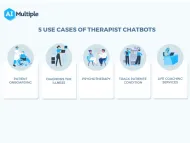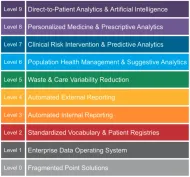Healthcare Hyperautomation: Use Cases & Best Practices [2024]
Hyperautomation was one of the top technology trends in 2022. According to IBM, healthcare in particular is a prime candidate to benefit from it, with so many repetitive processes and regulations to follow.
In this article, we’ll explore why hyperautomation is important for the healthcare industry, its use cases, its challenges and how to overcome them.
Why does the healthcare industry need hyperautomation?
Hyperautomation is an emerging approach to digital transformation that involves automating every business process possible while digitally augmenting those processes that can’t be automated fully. The need for hyperautomation is not different from the need for digital transformation: According to Gartner, hyperautomation is inevitable and is quickly becoming a condition of survival instead of an option for businesses.
The healthcare industry also has its own unique challenges that require hyperautomation to address:
- Consumer preference is rapidly shifting to digital, and the COVID-19 pandemic has accelerated this trend. Patients demand more convenient, transparent, and personalized healthcare services. Healthcare providers are aware of this trend as more than 90% of healthcare technology executives say achieving a better patient experience is their top desired outcome when implementing digital technologies.
- Legacy systems are still the norm in the healthcare industry. 80% of healthcare organizations use legacy systems that no longer receive support from their manufacturers. Replacing these systems is a challenge because it can disrupt operations and lead to integration issues. By leveraging hyperautomation tools with screen scraping and OCR capabilities, healthcare businesses can integrate these systems with modern technologies and automate the operations relying on them.
What are the use cases of hyperautomation in healthcare?
We have explored use cases of individual hyperautomation technologies in healthcare, such as:
- Artificial intelligence (AI)
- Intelligent automation
- Robotic process automation (RPA)
- Computer vision
- Chatbots
- Process mining
- Digital twins
Hyperautomation combines these technologies for end-to-end process automation. Use cases include:
1. Patient services
A combination of conversational AI and intelligent process automation bots can handle most patient service tasks, improving patient experience and employee productivity. Bots can:
- Interact with patients about their health problems through different channels,
- Enable self-service scheduling by providing patients with suitable physicians and time slots,
- Send reminders and allow rescheduling or canceling appointments,
- Collect data from patient interactions to be analyzed for customer service improvement,
- Assist human customer service reps during their customer interactions.
2. Regulatory compliance
Healthcare providers, health insurance companies, pharmacies, and other healthcare entities must comply with regulations such as HIPAA in the US and GDPR in the EU. Failure to comply with such regulations can lead to fines ranging from $100 to $100,000 per violation. Since a fifth of healthcare employees would be willing to sell patient data to unauthorized parties for as little as $500, adopting digital technologies is imperative for compliance.
Hyperautomation can help with ensuring regulatory compliance for healthcare organizations:
- Intelligent bots can log every action in healthcare systems and document the activity log when demanded,
- AI/ML models can be used to predict potential healthcare fraud,
- Automating internal audit processes can help evaluate risks and internal controls more efficiently and frequently.
3. Research & development
Hyperautomation technologies such as AI models and digital twins can accelerate pharmaceutical R&D:
- Drug discovery: Deep learning algorithms can be used to discover drug candidates for specific diseases.
- Testing new drugs: To test new drugs and treatments, companies can use digital twins to build digital representations of tools, drugs, human organs, genomes, or individual cells.
4. Health insurance processing
Processing claims efficiently is important for health insurance companies since:
- Nearly 90% of customers say effective claims processing influences their decisions when choosing a vendor,
- In the US, claim submissions account for $4.5 billion of medical industry spending, representing 13% of all administrative transactions.
- Around $300 billion is lost each year due to health care fraud in the United States.
By leveraging NLP methods and AI/deep learning models, a hyperautomation approach can help health insurance businesses:
- Minimize manual work during preauthorization and claims processing,
- Reduce human errors,
- Detect and prevent healthcare fraud more accurately,
- Ensure customer satisfaction with shorter claims cycles.
What are the challenges and how to overcome them?
- Data privacy: Medical data contains highly sensitive patient information protected by data privacy regulations. This can create a roadblock on the path to hyperautomation for healthcare organizations. Businesses must invest in privacy enhancing technologies (PETs) to develop innovative products without risking patient privacy.
- Process understanding: Processes are often poorly documented, and businesses may lack a comprehensive understanding of them. Process mining tools and digital twins can help businesses understand how actual processes are carried out and how to improve them. In this way, healthcare organizations can prepare themselves for their journey toward hyperautomation.
- Change management: Building a company culture around hyperautomation is just as important as selecting specific tools, since cultural deficit is one of the main reasons why digital transformation initiatives fail. Organizations should create opportunities for reskilling and upskilling and improve top-down communication about why these changes are needed. For more, check our article on the importance of organizational culture for digital transformation.
Check our article on intelligent automation strategy for more.
Further reading
If you have other questions about hyperautomation and its applications in the healthcare industry, feel free to reach us:

Cem has been the principal analyst at AIMultiple since 2017. AIMultiple informs hundreds of thousands of businesses (as per similarWeb) including 60% of Fortune 500 every month.
Cem's work has been cited by leading global publications including Business Insider, Forbes, Washington Post, global firms like Deloitte, HPE, NGOs like World Economic Forum and supranational organizations like European Commission. You can see more reputable companies and media that referenced AIMultiple.
Throughout his career, Cem served as a tech consultant, tech buyer and tech entrepreneur. He advised businesses on their enterprise software, automation, cloud, AI / ML and other technology related decisions at McKinsey & Company and Altman Solon for more than a decade. He also published a McKinsey report on digitalization.
He led technology strategy and procurement of a telco while reporting to the CEO. He has also led commercial growth of deep tech company Hypatos that reached a 7 digit annual recurring revenue and a 9 digit valuation from 0 within 2 years. Cem's work in Hypatos was covered by leading technology publications like TechCrunch and Business Insider.
Cem regularly speaks at international technology conferences. He graduated from Bogazici University as a computer engineer and holds an MBA from Columbia Business School.
To stay up-to-date on B2B tech & accelerate your enterprise:
Follow on

Comments
Your email address will not be published. All fields are required.